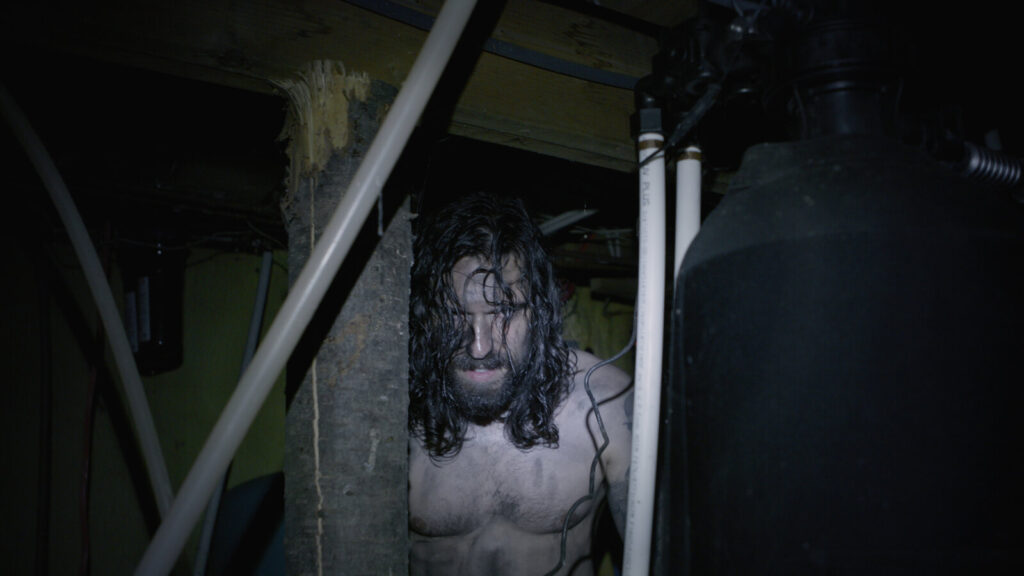Dream Eater filmmakers and horror legend Eli Roth discuss bringing this incredible and terrifying found footage film to life.

The world of found-footage horror just got a terrifying new entry that has already earned the stamp of approval from a master of the genre. Director, producer, and horror icon Eli Roth has championed the chilling new film, Dream Eater, a micro-budget shocker from debut filmmakers Jay Drakulic, Mallory Drumm, and Alex Lee Williams.
In this interview with Mama’s Geeky, the filmmaking team discussed the film’s intensely personal origins, the grueling nine-day shoot that tested their limits, and the crucial, last-minute intervention by Roth that changed the film’s finale forever.
Stripping Away The Comfort Zone
Dream Eater follows a couple, Alex and Mallory (played by the co-directors Williams and Drumm), whose relationship is pushed to its breaking point when Alex begins to suffer from severe parasomnia – a sleep disorder involving abnormal or unnatural movements, behaviors, and dreams. The resulting footage, shot mainly from a camera recording the couple while they sleep, transforms the most secure space on Earth – the bedroom – into a relentless psychological hell.
For the filmmakers, the premise was rooted in personal experience. Mallory Drumm explained the unique terror the team wanted to achieve: “You know, I think first and foremost, we really just wanted to be able to strip away people’s comfort zones. And where do you feel the most comfortable? At home, in bed, lying next to your loved one.”
The story became deeply personal, drawing on their own nocturnal anxieties. Jay Drakulic revealed: “Both Alex and I grew up having night terrors, Jay grew up sleepwalking. So we kind of like added in a bit of personal experience in there.”
The crew’s goal was nothing less than genre-defining. “We always say like, Jaws made you change the way you went into water. Psycho made you change the way you take a shower,” Drumm stated. “And we really want Dream Eater to change the way you go to bed at night.”
The $40,000 Discovery: Eli Roth’s Support
Eli Roth’s involvement was a moment of serendipity. He learned of the film not through an agent or a festival submission, but from a viral TikTok post by a movie influencer.
“It was just one of those weird things where someone sent me a link to a TikTok that Chuck Shaughnessy, Your Movie Guy, posted where he was just raving about this movie,” Roth recalled. Intrigued by the “very disturbing and striking” imagery, he reached out directly via Instagram.
Roth was instantly captivated by the film’s raw, unrelenting terror. He drew parallels to the genre’s most revolutionary works. “I remember watching Paranormal Activity for the first time and Blair Witch Project for the first time when you really don’t know what you’re getting into,” he said. “It just gets you, there’s that moment where the movie just turns and it’s – I was like, ‘Oh my god, I’m legitimately scared. This is really scary.’”
The final moments, in particular, left a powerful impression. “I don’t think there’s anything that’s scaring her in a movie this year,” Roth asserted. “I was legitimately heart racing, scared, just dreading every time it’s nighttime, they’re going to sleep.”
The biggest shock, however, came when he learned the budget. “I thought they made this for a million, a million and a half dollars. And they told me they made it for $40,000. I was legitimately shocked.”
For Roth, this level of achievement with such minimal resources demanded support. “Those are the people I want to support – people that make it on just raw passion and talent,” he stressed, praising the film’s “meticulous” sound design and score. “Horror fans love a discovery. And I think this movie truly is a discovery, and it deserves to be seen in theaters. I didn’t want it to get lost on a streamer.”
A Perfect Finale: Eli Roth’s Crucial Input
The decision to acquire and theatrically release the film led to a small but game-changing edit: the ending. Roth was the first to offer honest, constructive criticism.
“My job, if I’m going to be a producer, is to be honest with them, and you trust the filmmakers, but I’m telling them, you know, this is what didn’t – the only thing that fell short for me was this,” Roth said.
The filmmakers were ecstatic when Roth’s note aligned with an ending they had originally scripted but had been talked out of. Jay Drakulic was quick to credit Roth for the final, terrifying shot: “If it wasn’t for Eli, we never would have been able to recapture the spirit of what we were going for with our original scripted ending… so cool to get a second chance, a second opportunity at that.”
Roth emphasized the importance of a knockout conclusion in the found-footage subgenre: “These movies can live or die in that last shot, whether it’s Blair Witch, Paranormal, or reallyif you can have a really, really scary finale build up to that finale, then then you have a winner. And these guys did it. They nailed it. I jumped. I got chills at the end of it.“
Wearing Multiple Hats Allowed The Team To Tackle Challenges In Unexpected Ways
The production was famously lean, with the three co-directors making up a significant portion of the eight- or nine-person crew. Drumm and Williams also played the leads, a daunting challenge that required balancing performance with logistics.
Mallory Drumm reflected on the intensity: “Honestly, I think just exactly what you’re saying, like wearing all of the hats and doing all of the things is difficult… we did this movie in nine days with a crew of eight or nine people, three of which were us.” She credited the rigorous pre-production: “We spent months… blocking everything so that when we did arrive up at the location, any challenges that we did face, we felt super prepared to then just like pivot on the spot.”
One of the biggest anxieties for Alex Lee Williams was maintaining the integrity of the performance while managing the set. “Will we be sacrificing something in the performance? Like that was always in the back of my head,” he admitted. The solution was full commitment: “Just throw yourself at it. Don’t think about how it looks or sounds, just go with how it feels in this moment.”
The crew’s ability to treat limitations as opportunities was essential. When an exterior shot was blocked by heavy snow, Jay Drakulic recalled: “We looked at it as something that was creatively liberating.” It resulted in a memorable scene where Williams’s character chops wood, a skill he learned five minutes before the cameras rolled.
Roth praised the director-actors’ bravery, noting they had to do stunts and scenes that many professional actors would refuse. “You have two of the three directors that are acting in it, and that have to direct and act,” Roth said. “Then you have Alex, who has to act as waking Alex, and then acting as sleepwalker Alex – that’s like three jobs. And then Mallory has to put herself through this in terrible trauma.”
Found Footage & The Intimacy of Terror
The filmmakers explained why the found-footage approach was necessary for their story, citing the crucial narrative justification of documenting parasomnia.
Alex Lee Williams articulated the appeal: “With found footage, which it’s funny, because people inherently think that found footage is an easy sub-genre to tackle when, when really it that is just mistaken.” The biggest difficulty, he noted, is justifying the camera being on. “Your narrative has to be strong enough to inform why the camera is on and then you that has to be sold through the actors.”
The format provides a unique intimacy. Mallory Drumm elaborated: “The intimacy, watching things that you feel like you shouldn’t be watching. And then exactly what Jay said, like now that the camera acts as a character, you as an audience member can put yourself like, as if you’re in the camera as well.”
For Eli Roth, the authenticity is key: “When it’s found footage, you’re like, they’re really fucking doing it… when you see these guys in the snow, and they’re barefoot, you feel that pain, they’re really doing it, they’re not faking.”
The Adrenaline Of The Audience Pop
After pouring years of their lives into the film, watching it with a theater audience was the ultimate payoff.
Alex Lee Williams described the experience as “very surreal,” recalling the honor of sitting next to Roth at the Beyond Fest screening. “When you’re the person who poured years into it, and especially with alongside your best friends, being able to look around and see people jump at those moments that you had crafted meticulously, you plan for that to happen. And it surprises them is like a feeling that’s indescribable.”
Jay Drakulic added that the experience turns into “market research” after a few viewings. “We’re all nudging each other. We’re like, see that one over there? That was, I didn’t expect them to do it at that time. Like, yeah, it’s literally just like, just gathering data.”
Roth concluded the conversation by reinforcing his mission to champion the film and its creators: “Hopefully people get the same obsession with Dream Eater… They got to, you know, get out there and support some new filmmakers. That’s what it’s all about. Blood in the genre, giving other people a chance. And if the movie works, it makes it easier for me to do it for other directors, too.”
Dream Eater is in theaters now.
NEXT: “Emotion is the New Punk”: Guillermo del Toro & Cast On A Profoundly Human Frankenstein

Tessa Smith is a Rotten Tomatoes Tomatometer-approved Film and TV Critic. On Camera personality and TV / Film Critic with 10+ years of experience in video editing, writing, editing, moderating, and hosting.

